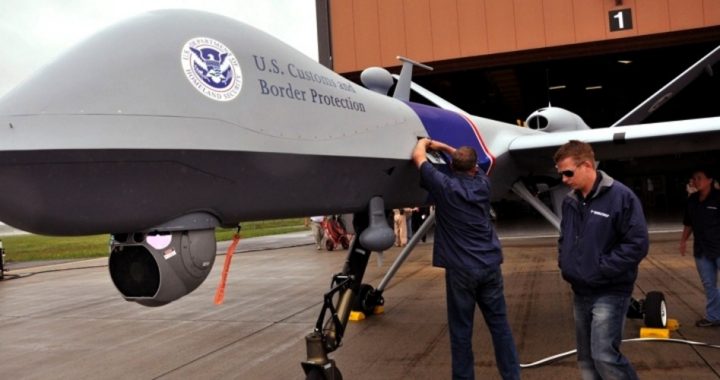
Think state and local law enforcement aren’t watching you with high-tech federally-owned drones? Think again.
In a new post, the Electronic Frontier Foundation (EFF) reports that Customs and Border Protection (CBP), a division of the Department of Homeland Security, released an updated list of “times the agency has flown its Predator drones on behalf of other agencies — 500 flights in total over a three-year period.”
Some of the more interesting revelations contained in the report — obtained by EFF as a result of a Freedom of Information Act (FOIA) lawsuit — include the fact that CBP drones flew more than 100 missions on behalf of the Department of Justice.
As the EFF story indicates, this level of cooperation between CBP and the Department of Justice “is in direct contradiction to a recently released DOJ Office of Inspector General (OIG) Report (pdf) that stated DHS had flown its drones on only two occasions for DOJ law enforcement components.”
Although many of the agencies borrowing CBP drones were revealed in earlier lists, there are a few new entries: “Grand Forks SWAT, the North Dakota Narcotics Task Force, the Bureau of Indian Affairs, the Arizona Department of Public Safety, the Minnesota Drug Task Force, and several branches of the military.”
Read that again: “Several branches of the military” are flying drone missions above the United States. For what lawful purpose could the armed forces be conducting such operations domestically? Furthermore, the likelihood is high that such activities run afoul of the Posse Comitatus Act, which prohibits the U.S. military from performing domestic law-enforcement duties.
In addition to the military and its fellow federal agencies, the CBP admitted that it is lending its drone fleet to “several county sheriff’s departments.” In the document provided to EFF, the CBP refused, however, to identify the names of the local law-enforcement departments borrowing these aircraft. CBP claims that to disclose the identity of the police departments or sheriff’s offices using its drones would “reveal that CBP is aware of the illegal activities taking place in a particular location.”
Seemingly, CBP believes (or claims to believe) that if it were to list these lenders, the criminals in those regions would be tipped off to the surveillance and would thus escape arrest.
Perhaps most fearful of all is that despite official recommendations and reprimands, the CBP refuses to promulgate any sort of code of conduct for drone flights that would explicitly protect the privacy rights of Americans protected by the Fourth Amendment.
The Fourth Amendment mandates:
The right of the people to be secure in their persons, houses, papers, and effects, against unreasonable searches and seizures, shall not be violated, and no warrants shall issue, but upon probable cause, supported by oath or affirmation, and particularly describing the place to be searched, and the persons or things to be seized.
As the Office of the Inspector General recognizes, drones are something apart from traditional surveillance aircraft and raise “unique concerns about privacy and the collection of evidence.” This distinction arises chiefly because of drones’ “pervasive tracking of an individual’s movements.”
Is there in fact a legal distinction to be made between the level of search conducted by the human eye (whether the searcher is on foot or in a helicopter) and that of a drone’s powerful never-blinking optics? Such an inarguable increase in police perception is not an insignificant decrease in the privacy expectation enjoyed by landowners and protected for centuries by timeless principles of Anglo-American law.
Given this encroachment into the formerly sacrosanct territory of individual liberty, Americans are right to resist the government’s apparent plan to fill the skies of our Republic with remote-controlled agents of the president and police.
In point of fact, a warrant becomes unnecessary when the search is being conducted using a drone. The target of the hunt will likely be unaware that he is being tracked and thus government (at any level) can keep a close eye on those considered threats to national (or local) security without having to permit the eye of the court to look over their shoulder.
Regardless, CBP has been running the loan-a-drone program for years.
Beginning in 2006, CBP began purchasing (as yet) unarmed Predator drones to purportedly aid in securing America’s southern border. According to a report written by the DHS inspector general, as of the end of 2012, CBP will have 12 of these aircraft in its arsenal with a total cost to taxpayers of nearly $200 million.
Inexplicably, the CBP took delivery of two drones in 2011 and 2012 despite the inspector general’s statement that “CBP had not adequately planned resources needed to support its current unmanned aircraft inventory.”
So, since they weren’t using the drones they already bought, why not buy more?
Although that spendthrift attitude is typical of government agency budgeting, perhaps the purchase of Predators is motivated by a goal a bit more sinister than either DHS or the Obama administration is willing to admit.
These other purposes are even hinted at in the DHS report. The tasks being performed by the CBP drones extend well beyond the patrolling of the border and into many other areas, a situation described by one reporter as “mission creep.” Here is a brief catalog of some of the ways CBP is farming out its drone fleet.
CBP Predators have been used to conduct missions for the following federal and state government agencies: U.S. Secret Service, Federal Emergency Management Agency (FEMA), Immigration and Customs Enforcement (ICE); Bureau of Land Management; Federal Bureau of Investigation; Department of Defense; Texas Rangers; U.S. Forest Service; and National Oceanic and Atmospheric Administration (NOAA).
With regard to ICE’s use of the CBP drone, the inspector general’s report indicates that the aircraft “provided surveillance over a suspected smuggler’s tunnel, which yielded information that, according to an ICE representative, would have required many cars and agents to obtain.” Yes, without the loan-a-drone program, the ICE surveillance mission would have required “many cars and agents,” as well as a warrant. With a drone, the government doesn’t need no stinkin’ warrant.
In a separate report issued in April 2012 by the Department of Defense, the Pentagon revealed the locations of over 100 new domestic sites that could soon serve as launch sites for military drones.
The list of present and proposed drone bases includes 39 of the 50 states, as well as Guam and Puerto Rico.
The EFF’s revelations concerning CBP’s willingness to keep its drones airborne on behalf of federal, state, and local law enforcement and other agencies are disturbing.
States, if they wish to protect their citizens from such constant surveillance, should follow James Madison’s advice and demonstrate their “refusal to cooperate with officers of the Union” in the latter’s effort to convert all citizens into suspects.
Photo of U.S. Customs and Border Protection MQ-9 Reaper drone: AP Images
Joe A. Wolverton, II, J.D. is a correspondent for The New American and travels frequently nationwide speaking on topics of nullification, the NDAA, and the surveillance state. He is the host of The New American Review radio show that is simulcast on YouTube every Monday. Follow him Twitter @TNAJoeWolverton and he can be reached at [email protected]



